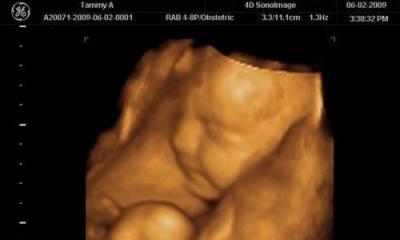Every woman goes through pregnancy differently. Feelings are especially different in women in the third trimester, after 6 months. By this time, expectant mothers have a feeling of heaviness and fatigue. You have to adapt to the sluggishness and constantly changing figure. Most pregnant women experience weakness and fatigue. This is precisely the reason for issuing maternity leave at this time, because now it is already difficult for a woman to carry out the necessary amount of work.
31 weeks of pregnancy - the middle of the 8th obstetric month. There is very little time left before the birth of the baby. For each woman, the period of bearing a child is individual. The onset of labor 15-20 days ahead of schedule refers to the normal development of events. Calculation of the date of birth is always approximate.
Fetal development at this time
Now the baby is growing and developing rapidly. By week 31, the weight of the fetus is approximately 1600 grams, and the height is about 41 cm. It is already difficult for the child to move in the womb. In search of a comfortable position, the baby takes a certain position. This is usually a "knuckle up" position, with crossed arms and legs upside down, which can be seen on a planned ultrasound. For many children, this position becomes permanent and does not change until birth.
Every day the child changes a little, grows up. The face acquires a refined outline, the nose becomes the correct shape, the auricles and neck continue to develop, become more dense. The eyes can react to bright light, the child squints, opens and closes his eyes, he has the ability to focus his eyes. In addition, the baby is forming a corneal reflex, i.e. accidental touching of the eye causes a defensive reaction, the baby squints.
The brain develops intensively, its convolutions are formed. The work of the nervous system is constantly being improved. The lungs and lung tissues become more mature, the production of surfactant begins, due to this, the child takes his first breaths of air after birth. At this period of development, hepatic bile begins to be produced, so the liver is preparing to cleanse the body of harmful substances, i.e. perform its main function. The work of the pancreas becomes more perfect, it begins to produce insulin.

 At 31 weeks, the fetus acquires the features of a fully formed baby: the proportions of the body change, the face stretches and acquires refined features. At 31 weeks, the baby is already becoming viable, that is, with early birth, the baby will complete its development already outside the womb
At 31 weeks, the fetus acquires the features of a fully formed baby: the proportions of the body change, the face stretches and acquires refined features. At 31 weeks, the baby is already becoming viable, that is, with early birth, the baby will complete its development already outside the womb The skin of the fetus is still wrinkled with a red tint. Due to the fact that the skin is very thin blood vessels are visible through the skin. There is an active growth of the nail plate, in the near future the nails will cover the entire surface of the nail bed. Just from the third trimester of pregnancy, the unborn child begins a noticeable and rapid weight gain. An increase in the amount of subcutaneous fat contributes to the proper regulation of heat exchange processes after the baby leaves the mother's womb.
The life of the unborn child at 31 weeks
Some babies already have a daily routine, a woman can notice moments during the day when the child becomes active, moves and calms down, falls asleep. The child moves more, causing serious discomfort to the expectant mother, even causing pain. The child actively moves his arms and legs, hitting the walls of the uterus. Excessively active movements at 31 weeks may indicate oxygen starvation of the fetus, or signal that the mother's position causes discomfort to the baby.
During pregnancy, it is necessary to pay special attention to fetal movements. If a woman does not notice the baby's movements for a long time, you need to urgently contact a gynecologist in charge of the pregnancy, perhaps undergo an extraordinary ultrasound. Normally, the fetus should remind itself of itself with active movements at least 10 times in 12 hours.

 At this stage of pregnancy, the expectant mother may periodically feel the movements of the baby in the tummy. You need to be very attentive to this indicator: if the fetus does not give signals about its movements for a long time, you need to contact a gynecologist - pregnancy may die
At this stage of pregnancy, the expectant mother may periodically feel the movements of the baby in the tummy. You need to be very attentive to this indicator: if the fetus does not give signals about its movements for a long time, you need to contact a gynecologist - pregnancy may die Ultrasound procedure
Usually, at the 31st week of pregnancy, a third planned ultrasound examination is performed, the purpose of which is to monitor the development of the child, to assess the compliance of indicators with the norm. This ultrasound allows you to assess the degree of development of the brain and other internal organs. If an ultrasound at 31 weeks is performed in 3D or 4D format, you can clearly see all the outlines of the baby's face. Poor visualization of a clear image on ultrasound can be due to several reasons:
- increase in the subcutaneous fat layer of a woman;
- small volume of amniotic fluid;
- the fetus is in an uncomfortable position for studying.
It is very difficult to obtain high-quality photographs and videos of ultrasound in late pregnancy. Determining the sex of the baby is carried out at the second planned ultrasound, however, the formation of the genital organs continues now. At this time, testicular prolapse has not yet occurred in male children, and future girls are still with open labia.
Normative ultrasound indicators
The main task of ultrasound at 31 weeks is to eliminate the lag in the development of the child. This is done using fetometry. Ultrasonic fetometry is a procedure for measuring the length of bones and assessing the main structural characteristics.
The norm of the size of the fetus by ultrasound at 31 weeks:
- biparietal size (BPR): 73 - 87 mm .;
- fronto-occipital size (LB): 93 - 109 mm .;
- head girth (OG): 273 - 215 mm .;
- girth of the abdomen (coolant): 247 - 301 mm.
Normally, the lengths of the main bones measured by ultrasound correspond to the following values:
- thigh: 55 - 65 mm.;
- shoulder: 50 - 60 mm.;
- forearm: 45 - 53 mm.;
- lower leg: 50 - 60 mm.
With Doppler ultrasound at 31 weeks, the normal values are as follows:
- placental vascular resistance index: 0.34 - 0.61;
- umbilical artery resistance index: 0.53 - 0.76;
- systolic-diastolic ratio of blood flow velocity in the umbilical artery: 2.88 - 2.96;
- systolic-diastolic ratio of blood flow velocity in the fetal cerebral artery: above 4.4;
- fetal cerebral artery resistance index: 0.8;
- BCA resistance index: 0.8 - 0.85.
 In addition to conventional ultrasound, according to indications, dopplerometry is used - checking the speed and direction of blood flow in the vessels of the placenta, umbilical cord - the data obtained make it possible to determine whether sufficient nutrition for the fetus comes from the mother's body
In addition to conventional ultrasound, according to indications, dopplerometry is used - checking the speed and direction of blood flow in the vessels of the placenta, umbilical cord - the data obtained make it possible to determine whether sufficient nutrition for the fetus comes from the mother's body Possible complications of pregnancy
From 31 weeks, the main stage of fetal growth begins. In this regard, a pregnant woman should pay special attention to her health and weight gain. Normally, weight gain should not exceed 300 grams. in 7 days. If body weight increases much more intensively than recommended, you should consult a gynecologist. Intensively increasing weight with a healthy diet indicates the possible development of edema.
This period of pregnancy is characterized by the development of various complications. Knowing the symptoms will allow you to take timely measures to prevent the development of critical complications.
The reason for an urgent visit to the doctor are the following symptoms:
- Sensation of ripples before eyes. This is a symptom of high blood pressure or the development of internal edema.
- Persistent swelling of the extremities. Persistent swelling of the legs indicates possible violations of the kidneys.
- Constant feeling of tiredness and seizures. Signs of late toxicosis.
- Headache, bouts of dizziness are unfavorable signs of unstable pressure or the development of a preeclampsia.
- Symptoms of polyhydramnios or oligohydramnios in the third trimester of pregnancy are usually detected using ultrasound diagnostics.
- A consequence of acute respiratory diseases suffered by a woman during pregnancy can be a variety of complications.
- Intestinal upset in a pregnant woman occurs as a result of hormonal changes in the body. However, it is worth paying attention to such symptoms, since diarrhea sometimes indicates a possible intestinal infectious disease.
Anxious highlights
At 31 weeks, a pregnant woman should treat her health with increased attention. The presence of vaginal discharge is normal.
However, any slight change should alert them. You should consult a doctor if you notice leakage of amniotic fluid. The normal volume of such secretions should not exceed 20 ml. Any slight change in the color of the discharge, the appearance of blood in them can be an alarming symptom, indicating a threat to the health of the child. You should consult a gynecologist when the first symptoms of thrush appear: curdled mucous secretions with a specific smell.








